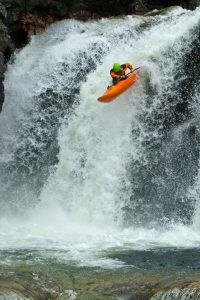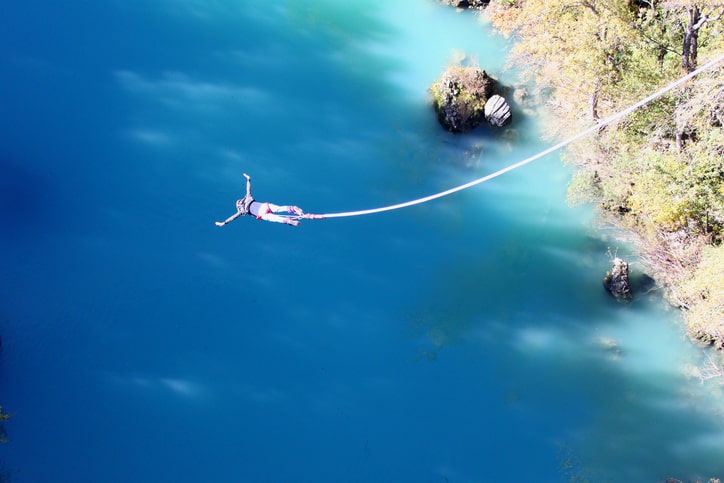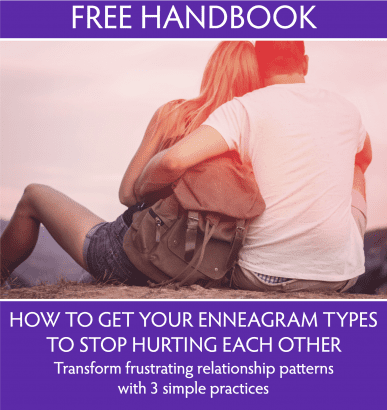Does the idea of skydiving, ice climbing, or drag racing intimidate you? Or thrill you? Or both?
Do you dread the thought of heading into the wilderness of your emotions and sensations? Or do you long to immerse yourself in them? Or both?
Navel Gazing and Bungee Jumping
It could be said that we humans are organized by fear. Fear compels us to great achievement, preparation, and avoidance. In the face of feeling our helplessness or insignificance, it is natural to want to change our experience of fear through distraction, pursuit, numbing out, combat, or escape.
Different Enneagram types will be able to recognize this more or less directly, but each of our inner platforms is structured to have us not feel our particular dreaded feeling and to experience ourselves in a particular way. We each have a core fear. Type Four, for example, feels “allergic” to experiencing the self as ordinary or mundane; at Four, I am reassured when I experience myself as unique, significant, or unusual.
Biologically, emotionally, mentally, relationally, culturally, and existentially we can rack up whole piles of fears. And by habitually trying to override or avoid our fears, most of us don’t realize the weight we are constantly carrying. Or the gold mine we’re pushing away.
The Compelling Ledge
Recently I was working with a client exploring her sense of emotional and energetic “flatness.” After some inquiry into her experience, she came upon a threshold where she felt resistance to going further into her sensations. She reported, “Ha! Interesting. It feels scary, but also kind of compelling and exciting – like ‘extreme sports’ thrilling.”
I recognized how true this has felt in my own experience- when it’s like I’m standing at the edge of an ominous ledge inside and my ego is screaming, “No! It’ll destroy you!”
This is often the case when we approach territories in ourselves that are unfamiliar or that threaten our usual sense of self. Many times, faced with a moment like this, we will turn away. Unlike my client who kept hanging in there with it, we will instinctually want to stop such experiences and distract, cover up, or fill ourselves up with something else.
Challenging the Ordinary
Some people seek out challenges in life to test or prove themselves, or to reach important goals. I remember when I was a student-teacher, I chose to work in an inner-city high school to challenge myself to move outside of the less diverse demographic I had grown up in. I wanted to learn and to expand my comfort zone, but I also felt compelled to put myself in that situation to overcome my feelings of inadequacy. I wanted to put myself to the test so I wouldn’t feel unsure anymore.
Some personality styles habitually challenge themselves and others to get a sense of power or of orientation about where they stand. Type Six, for example, might push against a partner or a boss to see whether they are solid, competent or whether they really care.
Others seek out daring situations to have an experience of freedom or expansion that feels beyond “ordinary” life. This is where I see a strong similarity between inner work and extreme sports. In both arenas, we choose to move toward and through what feels potentially life-threatening.
By extreme sports, I mean recreational activities with potential risk of serious or permanent physical injury or even death. Onlookers of extreme sports often find others’ attraction to these activities baffling. Is it a death wish? An addiction to adrenaline? Apparently not. In their research, Professors Brymer and Schweitzer found that
…people who engage in extreme sports are anything but irresponsible risk-takers with a death wish….They are highly-trained individuals with a deep knowledge of themselves… who do it to have an experience that is life-enhancing and life-changing….The experience is very hard to describe in the same way that love is hard to describe. It makes the participant feel very alive where all senses seem to be working better than in everyday life.
I remember at summer camp as a teen being required to complete a kayak flip test to make  sure we could escape properly in an emergency. Not being a very strong swimmer, I was afraid to roll my kayak and be fully submerged under it. But, because I couldn’t opt out of the task, and because there was reassuring structure there to walk me through it, I did it. I not only went through my fear, reducing its grip on me, I also got to experience my courage, my capacity and the pleasure of feeling more fully alive- largely from doing what I thought I couldn’t.
sure we could escape properly in an emergency. Not being a very strong swimmer, I was afraid to roll my kayak and be fully submerged under it. But, because I couldn’t opt out of the task, and because there was reassuring structure there to walk me through it, I did it. I not only went through my fear, reducing its grip on me, I also got to experience my courage, my capacity and the pleasure of feeling more fully alive- largely from doing what I thought I couldn’t.
Safety that Stifles
We all have a “stay safe” imperative in our psyches. Different people and personalities have different arenas we focus on, and different experiences of what safety means. For example, type Seven may feel threatened in a situation that ensures so much “safety” that there’s no room for options or creativity. Or as type Eight, I may feel unsafe when people are too careful with their words, feeling like there’s a hidden manipulation going on.
Have you ever noticed an internal panic or dread when you experience certain emotions or beliefs? I call this our “no-go zone” where the personality’s alarm bell gets set off. It is often a visceral feeling— sometimes like anxiety or nausea that essentially commands: “Stop! This is dangerous!”
It can be accompanied by orders such as:
“Don’t be that kind of person.”
“You’ll be rejected if you do that.”
“You’ll be hurt if you show that.”
In these moments, our inner alarm bell is really signaling something more global:
“Stop going outside the usual.”
“Don’t upset our world view.”
“Don’t experience yourself in new ways.”
To keep walking past these inner “No Trespassing” signs often feels frightening, but can also feel invigorating- like the thrill of rebelling, like an escape from a cage.
In that inner terrain it can feel treacherous because we experience fear on an existential level. We feel challenged on things that we unconsciously rely on. We are afraid to tell the truth about ourselves, to ourselves, that we are more than we’ve taken ourselves to be. We are afraid to see that the truth we’ve relied on might not be so True after all.
We get scared because it feels like our lives are in jeopardy in some way. With extreme sports, the physical and concrete risks are a key focus. In inner work, when our ego or self-image feels threatened, the fear about what it will mean about us can feel similarly endangering. In learning how to skillfully navigate in either arena, we can tap into new ways of experiencing ourselves and our surroundings that redefines our old notions of safety.
In The Places that Scare You: A Guide to Fearlessness in Difficult Times, Pema Chödrön writes:
We insist on being Someone, with a capital S. We get security from defining ourselves as worthless or worthy, superior or inferior. We waste precious time exaggerating or romanticizing or belittling ourselves with a complacent surety that yes, that’s who we are. We mistake the openness of our being—the inherent wonder and surprise of each moment—for a solid, irrefutable self. Because of this misunderstanding, we suffer.
“I Didn’t Die…”
When I support myself to go in and through my aversive emotions or usually avoided territory, I generally come out at least subtly transformed. The world seems different. I experience myself as more vital, resourced, or connected.
But throwing ourselves into what can feel life-threatening is not a casual thing. Skydiving  doesn’t work without a solid equipment, skillful coaching, precise timing and technique. And, when all of these things are in place, injury is rare. Likewise, in our scariest places internally, without proper support, we can tangle ourselves up in our parachute straps, or submerge the lifeguard who doesn’t know how to keep us in the proper position.
doesn’t work without a solid equipment, skillful coaching, precise timing and technique. And, when all of these things are in place, injury is rare. Likewise, in our scariest places internally, without proper support, we can tangle ourselves up in our parachute straps, or submerge the lifeguard who doesn’t know how to keep us in the proper position.
The point of “danger,” as it were, often does feel like life and death. Because our ego is in danger of losing its throne. Our “normal” world view is in danger of its ordinary convictions. The things we take for granted about life— that I’m a good person, that I’m a deprived person, that the world is harmonious, that the world is threatening— are in danger. In danger of being upgraded, expanded, or enhanced.
It feels like life and like death. Facing the risk of death can be tremendously enlivening— like confronting a bully, or telling your boss what you need in order to stay at the job you want to keep.
I remember in a session with my teacher many years ago I was feeling a profound sense of abandonment and neglect inside. I felt small and unworthy. My heart heavy, my posture collapsed, I didn’t want to see myself this way, let alone be witnessed by my teacher. However, her supportive presence and her confidence that there was a way to tolerate what seemed overwhelming to me, helped me take the next steps and not turn away from myself in this difficult place. Her grounded attention and compassion created the conditions for me to consider there might be another way through. As she coached me in working with my breath, my body, my attention, and the different aspects of myself, I felt my resistance softening. She had been a skydiver of psyche and spirit for a long time and knew how to lead me through.
I began that session feeling insecure, rejected and constricted. I came out of the session feeling seen, supported, capable, and in touch with my value. I felt these qualities reflected by my teacher, yes, but also felt I knew them directly and in a larger sense.
Don’t Go it Alone
To avoid peril in inner work and extreme sports we must learn how to ground into the
present moment, to stay centered in the face of our fears, and to use high-quality techniques and “equipment.” This is what allows “successful execution” and protects us from harm in these dramatic landscapes.
The presence of another who is skilled in these inner “sports” is essential, to help us not get overwhelmed, and offer us solid practices and safety techniques when we feel shaky.
Inner Fitness
The more times we go through the ordeal of facing, approaching, and enduring what is scary, the more we are likely to experience the benefits that come when we work with life this way.
Over the years, it is precisely this repetition of finding my way through these seemingly noxious or impenetrable places that has built up, layer by layer, a deep knowing in myself that I can relax more into whatever arises in me. I understand now that not only will there be a way through, and that I won’t die, but that it will likely lead to a rich and intimate experience of myself and of the nature of things.
People who are drawn to extreme sports also describe profound shifts in their perception of themselves and of life when they are radically present in the moment. The risk of injury or death requires a deep focus on our immediate experience. While immersed in the activity, and after we’ve made it through, there is often a sense of profound aliveness, contentment, peace and vitality that can be hard to come by in daily life’s tasks and roles.
Like extreme sports, inner transformation work can be thrilling in the moment, but the effect lasts longer than an amazing climb or a moment of transcendent awareness. I can carry it with me regardless of the scenery or what’s going on around me.
When life, as I’ve understood it, reveals over and over that it can be trusted, that what I’ve been afraid of all this time is just another little man behind the curtain, I find myself in a different posture toward life. I’m ready, willing and eager to engage whatever I encounter. My usual constrictions softened, I feel a freedom and a capacity to show up for myself and others with an open heart and grounded strength. This is what makes me want to return again and again to that compelling and scary inner terrain at the edge of my psyche and my soul.
Me and Explosives
As a summer job in college, I worked on the trail crew for the US Forest Service. Communing with nature, great exercise, fresh air, and the striking vistas I got paid to visit and care for were some amazing perks of the job. One perk I didn’t expect was to liberatingly shatter one of my self-images.
My boss on the crew was the Forest’s “Lead Blaster” who was tasked with using explosives when necessary to clear out avalanche debris from trails. Near the end of the summer, we learned of an enormous granite boulder that needed to be removed from a popular trail. We backpacked in several miles, carrying all of our signs, flags, safety gear, drill, chainsaw, and explosives – we’re talking nitroglycerin dynamite sticks.
At that age, I barely liked fireworks. I hated violent movies. I was a passionate pacifist. My self-image as type Nine was that I was peaceful and compassionate. I liked uniting and healing things, not tearing them asunder. So the idea of a massive explosion of nature in a wilderness area was not attractive to me. I was kind of shocked to be participating in it, actually.
But my boss was exhilarated. He loved this stuff. And after a day’s work of our crew setting up the site, it was time to detonate. My boss took the cord with the button on the end, and with a big smile and twinkly eyes, handed it to me. He was going to give me the “pleasure” of being the one to do the violent damage. Yikes!
Well, I did it.
And I loved it.
And that shocked me. That’s not the me I knew myself to be! Did I feel disturbed or liberated? I guess I felt both.
In hindsight, I imagine that participating in the explosion has helped me become aware of aspects of myself that aren’t as demure, careful, or unobtrusive as I used to imagine myself. I felt my own power, my potential to destroy obstacles in my path, as it were. My playground had become bigger and wider. My sense of self more spacious and less afraid. And, much to my superego’s surprise, that experience did not cause me to like violence, become callous or seek destruction!
Life is as Thrilling as You Allow it to Be
Maybe, in a way though, I have become a thrill-junkie. It always thrills me when I loosen another knot in the tangle of my inner world, allowing myself more room to breathe and move. It always thrills me to help my clients face the frontiers they didn’t know how to walk through alone. I can’t imagine ever getting tired of supporting souls to get out on the dance floor of life and shake it.
So the next time you find yourself in uncomfortable inner territory, you might want to try tapping into your inner whitewater rafter, telemark skier, or fire dancer. You could ask:
- What if this experience were something I were seeking out instead of trying to end?
- How might I behave differently toward it?
- How might my focus of attention shift?
- What might I start to understand about my discomfort when I pay attention?
Bringing a spirit of adventure and courage to moments that feel fraught with danger (along with a huge backpack of presence and compassion), we can find that Life is waiting for us everywhere and that she wants us to be thrilled with her, to come toward her, to engage directly with her.










4 Responses
Great blog, Sarah. Loved the story at the end. That’s so you. And such a great intentional use of self-disclosure to get other people to think about themselves and their lives–very Milton Ericksonesque, if you ask me.
Our move, though not without complications, went smoothly and this Southerner (with a capital “S”) is now happily settling into the very northern part of southern MI. Hope your move went smoothly as well. Talk soon. John
Thanks John. Glad to hear your move went well! Look forward to hearing more later.
Terrific post Sarah. Great reminder of the times I’ve taken the leap before and that I just might be rounding the bend again into another encounter with the seemingly immovable barrier. There is exhilaration in blasting away the brittle parts of ego that no longer serve me. You describe this so well.
Thanks, Debra. It’s helpful for me to remember that this kind of boldness can come through me even (or especially) when I’m on my knees. May you sense your access to this as you round this bend.